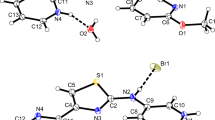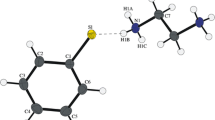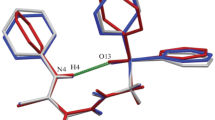Abstract
This article describes single crystal X-ray diffraction studies of two Schiff bases containing hydroxyl groups in aromatic rings: N-(4-hydroxybenzylidene)phenylethylamine (1) and N-(4-hydroxy-3-methoxybenzylidene)tyramine (2). Molecules of compound 1, with just one phenolic OH group, adopted an anti conformation, and were associated in zigzag chains with O–H···N hydrogen bonds between the azomethine fragment and the hydroxyl group. However, a gauche conformation was preferred by compound 2, which contained two hydroxyl groups in aromatic rings. Molecules of 2 were arranged in a three-dimensional array through O–H···N and O–H···O hydrogen bonding interactions. The results highlighted the importance of OH positions in the aromatic ring for the structural behaviour of the Schiff bases derived from phenylethylamines.
Graphical Abstract
Molecules of Schiff bases containing the moiety ArCH=N–CH2CH2Ar with one or two hydroxyl groups in the para position in the aromatic rings are associated in zigzag chains in the solid state through O–H···N hydrogen bonding interactions.

Similar content being viewed by others
Avoid common mistakes on your manuscript.
Introduction
Phenolic Schiff bases have drawn attention due to their important role in biological systems and great ability to coordinate metals and form liquid crystals. The formation of metal complexes, the stability of liquid crystals and the photophysical properties of these compounds are consequences of hydrogen bonds or proton transfer between phenolic hydroxyls and the nitrogen of the azomethine group [1,2,3].
Structural studies of phenolic Schiff bases derived from tyramine (4-hydroxyphenylethylamine) have revealed intermolecular interactions through hydrogen bonds between the phenolic hydroxyl from one unit of N-benzylidenetyramine with the imine nitrogen from the other, thereby forming infinite zigzag chains [4]. Continuing our studies related to the β-phenylethylamines’ chemical and structural behaviour [5], this article describes the single crystal X-ray diffraction (XRD) structural analysis of two N-benzylidenephenylethylamines having different degrees of hydroxylation: 4-hydroxybenzylidenephenylethylamine 1 and 4-hydroxy-3-methoxybenzylidenetyramine 2.
Experimental Section
Materials
The reagents (tyramine, phenylethylamine and aldehydes) were purchased from Aldrich and used as received and the solvents (Merck, analytical grade methanol and ethanol) were also used without further purification. A Nicolet iS10 spectrometer (Thermo Fisher Scientific, 4000–400 cm−1) was used for infrared (IR) analysis, using KBr disks. Nuclear magnetic resonance spectra were registered on a Bruker Avance 400 spectrometer with a direct probe (5 mm BBO BB-1H/2H) operating at 400.130 MHz for 1H and 100.634 MHz for 13C. DMSO-d6 was acquired from Merck.
N-benzylidenephenylethylamines Synthesis (1, 2)
The N-benzylidenephenylethylamines were synthesized following the procedure previously described [6].
N-(4-hydroxybenzylidene)phenylethylamine 1 (C15H15NO)
White solid, yield 80%, m.p. 187–189 °C, FT-IR (KBr) (cm−1): 3300–2200 and 1665. 1H NMR (DMSO-d6) (ppm): 2.88 (2H, t, J = 7.2 Hz), 3.71 (2H, t, J = 7.2 Hz), 6.76 (2H, d, J = 8.4 Hz), 7.19 (5H, m), 7.48 (2H, d, J = 8.4 Hz), 8.12 (1H, s). 13C NMR (DMSO-d6) (ppm): 37.6, 62.5, 62.5, 115.7, 126.2, 127.7, 128.4, 129.1, 129.8, 140.3, 160.1, 160.8.
N-(4-hydroxy-3-methoxybenzylidene)tyramine 2 (C16H17NO3)
Yellow solid, yield 90%, m.p. 223–225 °C, FT-IR (KBr) (cm−1): 3300–2200 and 1665. 1H NMR (DMSO-d6) (ppm): 2.76 (2H, t, J = 7.4 Hz), 3.66 (2H, t, J = 7.4 Hz), 3.78 (3H, s), 6.65 (2H, d, J = 8.4 Hz), 6.79 (1H, d, J = 8.0 Hz), 7.02 (2H, d, J = 8.4 Hz), 7.06 (1H, dd, J = 8.0 Hz, 1.7 Hz), 7.31 (1H, d, J = 1.7 Hz), 8.08 (1H, s). 13C NMR (DMSO-d6) (ppm): 36.4, 55.6, 62.4, 110.0, 115.1, 115.3, 122.7, 128.0, 129.8, 130.1, 148.0, 149.3, 155.6, 160.6 [6].
X-Ray Structure Determination of 1 and 2
Colourless single crystals were grown from ethanolic solutions of the N-benzylidenephenylethylamines 1 and 2 by slow evaporation at room temperature. Suitable crystals were selected with the aid of a microscope, mounted on a cryoloop with a layer of a viscous perfluoropolyether (Fomblin®Y) and placed in the low temperature nitrogen stream of the diffractometer. The intensity data sets were collected on a Bruker-Nonius KappaCCD diffractometer equipped with an Oxford Cryostream 700 unit. The molybdenum radiation was used, graphite monochromated and enhanced with a MIRACOL collimator. Table 1 shows the crystallographic data.
The WinGX package [7] was employed for solving structures by using intrinsic phasing methods (1) (SHELXT) or direct methods (5) (SHELXS-2013) [8] and refined by least-squares against F2 (SHELXL-2014/7) [9]. In both crystallographic studies all non-hydrogen atoms were anisotropically refined. The hydrogen atoms were positioned geometrically and refined using a riding model, except those of the imine groups [H(7) in 1 and 2] and the hydroxylic hydrogens [H(1) in 1, and H(3) in 2] which were located in the difference Fourier map and isotropically refined. Hydrogen H(1) of the hydroxyl group next to the methoxy fragment in structure of 2 was also found in the difference Fourier map. Unfortunately the isotropic displacement parameter obtained for H(1) was not appropriate, so the Uiso was forced to be 0.05 Å2. Moreover DFIX instruction was applied to constrain the distance O(1)–H(1).
Results and Discussion
Two benzylidenephenylethylamines were synthesized for the present study. The first, with a phenolic hydroxyl in its structure [N-(4-hydroxybenzylidene)phenylethylamine 1] was obtained by reaction of phenylethylamine with 4-hydroxybenzaldehyde. The second, with two hydroxyl groups in its structure (one on each aromatic ring) [N-(4-hydroxy-3-methoxybenzylidene)tyramine 2] was obtained by reaction of tyramine with vanillin [6].
Crystal structures of 1 and 2 were determined by single crystal XRD and analysed to gain information about the influence of phenolic hydroxyl groups on the crystal packing of Schiff bases with the moiety ArCH=N–CH2CH2Ar.
In the crystallographic study of the Schiff base N-(4-hydroxybenzylidene)phenylethylamine (1), the azomethine group presents an E configuration between the phenylethylamine and the 4-hydroxyphenyl fragments, with a torsion angle C(4)–C(7)–N(1)–C(8) of 179.6 (2)° (Fig. 1). Additionally, structure of 1 shows a torsion angle N(1)–C(8)–C(9)–C(10) of 176.1 (2)°, which is consistent with an anti-staggered conformation regarding rotation around C(8)–C(9) bond.
Molecules of 1 are associated by O–H···N hydrogen bonding interactions between the hydroxyl group and the imine nitrogen atom, with O(1)···N(1)i and H(1)···N(1)i distances of 2.747 (3) and 1.80 (3) Å respectively, and O(1)–H(1)···N(1)i angle of 169(3)° (symmetry transformation: (i) − x + 1, − y + 1, − z + 2). These hydrogen bonds lead to the formation of zigzag chains along the c axis, which are held together through C–H···π and π···π interactions (Fig. 2; Table 2) to generate corrugated layers. The zigzag arrangement in 1 is similar to those found for other Schiff bases with the moiety ArCH=N–CH2CH2Ar containing just one hydroxyl group in para position, as N-(4-nitrobenzylidene)tyramine and N-(4-methylbenzylidene)tyramine (Fig. 3) [4, 10]. Interestingly, Schiff bases containing an aromatic ring with just one hydroxyl group in ortho position do not show zigzag chains in the crystal packing [11,12,13,14].
Comparing with the structure of 1, the crystallographic analysis of the Schiff base N-(4-hydroxy-3-methoxybenzylidene)tyramine (2), with two hydroxyl groups in para positions, also reveals an E configuration for the azomethine group between the tyramine and the 4-hydroxy-3-methoxyphenyl units, with a torsion angle C(4)–C(7)–N(1)–C(8) of 173.4 (3)° (Fig. 4). However, a gauche conformation is adopted with a torsion angle around C(8)–C(9) bond quite different [torsion angle N(1)–C(8)–C(9)–C(10) of 60.4 (3)°], which is caused by the crystal packing.
Molecules of 2 are arranged in a zigzag motif (Fig. 5) by O–H···N hydrogen bonds between one hydroxyl group and the imine nitrogen atom, with O(1)···N(1)i and H(1)···N(1)i lengths of 2.792 (4) and 2.02 (3) Å respectively, and O(1)–H(1)···N(1)i angle of 161 (3)° [symmetry transformation: (i) − x + 1, y + 1/2, − z + 1/2]. Two non-classical C–H···O hydrogen bonding interactions contribute to maintain the zigzag pattern: C(3)–H(3a)···O(1)ii and C(8)–H(8a)···O(1)iii [Table 3, symmetry transformations: (ii) − x + 1, y − 1/2, − z + 1/2, and (iii) x, y − 1, z]. Furthermore, C(8)–H(8a)···O(1)iii interactions probably prompt to molecule of 2 to adopt the gauche conformation in solid state.
Additionally, the mentioned zigzag motifs are hold together in a three-dimensional arrangement by O–H···O and C–H···O hydrogen bonding interactions (Fig. 6; Table 3), with O(3)···O(1)iv and C(7)···O(3)v distances of 2.589 (3) and 3.635 (4) Å, respectively [symmetry transformations: (iv) − x + 1/2, − y + 1, z + 1/2, and (v) x − 1/2, − y + 1/2, − z + 1].
To the best of our knowledge, there are no examples of Schiff bases crystal structures containing the moiety ArCH=N–CH2CH2Ar with two hydroxyl functions in para positions. However, a few crystal structures were described with –OH groups bound to carbon atoms in para and ortho positions of different rings. In those Schiff bases, the imine nitrogen atoms were implied in O–H···N hydrogen bonding interactions with the hydroxyl groups in ortho, and the crystal packing revealed an array in zigzag chains which were built by O–H···O hydrogen bonds between both ortho and para OH groups [15,16,17,18]. The analysis of the crystal packing of 2 shows that the imine nitrogen atom and one of the hydroxyl function in para position are building a zigzag pattern, whereas the second hydroxyl group in para is implied in the construction of the three-dimensional arrangement.
Conclusion
Molecules of Schiff bases containing the moiety ArCH=N–CH2CH2Ar with one hydroxyl group in para position in an aromatic ring are associated in zigzag chains in the solid state through O–H···N hydrogen bonding interactions. The zigzag chains also appeared in Schiff bases crystal structures with one hydroxyl function in ortho position and a second OH group in para in the other aromatic ring, by forming O–H···O hydrogen bonds. Although a zigzag pattern could also discern in the XRD analysis of Schiff bases with two hydroxyl functions in para position, the crystal packing could be better described as a three-dimensional arrangement stabilised by O–H···N and O–H···O hydrogen bonds. The results confirmed that position of OH groups in phenylethylamine derivatives affects the structural behaviour of these compounds.
Supplementary Data
CCDC 1883771–1883772 contain the supplementary crystallographic data for this paper. These data can be obtained free of charge from the Cambridge Crystallographic Data Centre via.
References
Nazir H, Yildiz M, Yilmuz H, Tahir MN, Ülkü D (2000) J Mol Struct 524:241
El Mali A, Kabuk M, Elerman YJ (1999) J Mol Struct 484:229
Cinarli A, Gürbüz D, Tavman A, Birteksöz S (2011) Bull Chem Soc Ethiop 25:407
Maldonado M, Perez-Redondo A, Quevedo R (2017) J Mol Struct 1127:689
Quevedo R (2016) Non-covalent Interactions in the synthesis and design of new compounds, vol 49. Wiley, New York
Quevedo R, Díaz-Oviedo C, Quevedo-Acosta Y (2015) Res Chem Intermed 41:9835
Farrugia LJ (2012) J Appl Crystallogr 45:849
Sheldrick GM (2008) Acta Crystallogr A 64:112
Sheldrick GM (2015) Acta Crystallogr C 71:3
Siddiqui H, Bashir MA, Javaid K, Nizamani A, Bano H, Yousuf S, ur-Rahman A, Choudhary MI (2016) J Enzyme Inhib Med Chem 31:1392
Chatziefthimiou SD, Lazarou YG, Hadjoudis E, Dziembowska T, Mavridis IM (2006) J Phys Chem B 110:23701
Räisänen MT, Leskelä M, Repo T (2007) Acta Crystallogr E 63:o1816
Yaeghoobi M, Rahman NA, Ng SW (2009) Acta Crystallogr E 65:o1070
Ahmad JU, Nieger M, Sundberg MR, Leskelä M, Repo T (2011) J Mol Struct 995:9
Li YG, Zhu HL, Huang WQ, Ai L (2006) Acta Crystallogr E 62:o689
Dong X, Li Y, Li Z, Cui Y, Zhu H (2012) J Inorg Biochem 108:22
Fang RQ, Song T, Li YX (2012) Acta Crystallogr E 68:o332
Zeyrek CT, Koçak SB, Ünver H, Pektaş S, Başterzi NS, Çelik Ö (2015) J Mol Struct 1100:570
Acknowledgements
We would like to thank the Universidad Nacional de Colombia (DIB Research Project No. 37398) and Universidad de Alcalá (CCGP2017-EXP/021) for providing financial support.
Author information
Authors and Affiliations
Corresponding author
Additional information
Publisher's Note
Springer Nature remains neutral with regard to jurisdictional claims in published maps and institutional affiliations.
Rights and permissions
About this article
Cite this article
Chaves, S., Pérez-Redondo, A. & Quevedo, R. Solid State Structure and Intermolecular Interactions of two N-Benzylidenephenylethylamines. J Chem Crystallogr 50, 206–211 (2020). https://doi.org/10.1007/s10870-019-00792-7
Received:
Accepted:
Published:
Issue Date:
DOI: https://doi.org/10.1007/s10870-019-00792-7










